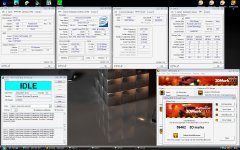I don't think we can blame Intel solely for AMD's Bulldozer era.
Like most things its a combination of things, Intel's shenanigans hit AMD hard financially but so did the 2008 crash, and Bulldozer was a mistake on AMD's part, one that they didn't have the cash to put right quickly, the low performance was exacerbated by Windows not knowing what to do with it.
Bulldozer was a programmable hybrid architecture, it had 8 physical cores but in four two core clusters via a switchable unified L2 cache.
That L2 cache for each two core cluster could run 2X 128Bit, one for each core or combine to a single 256Bit L2 to make those cores one big one.
What was supposed to happen was if you needed a lot of multitasking you would have up to 8 physical cores, if what you needed was single threaded performance the L2 cache would combine the two cores in the cluster to give a much fatter core.
This never happened, instead Windows would treat it like a normal 8 core CPU, so it would only ever use one half of the switchable L2 and with that you never got the fat double core.
I don't know why this was never resolved through the life of that architecture, this was also during a time when Microsoft had no interest in resolving the issues with their ancient Direct X, very much a "we don't have competition so lets spend 0$ and do nothing" That is something AMD had to resolve themselves as well, but that's another story.
Anyway, its good to see AMD back on form.
Edit: also, i don't think CPU's are expensive, entry level £200 CPU's these days are pretty good, from both AMD and Intel, you can get the latest and greatest monster CPU's for under £600.
The highest end Gen 1 Zen was $500, a 7950X is more than 4X as fast as that for $100 more, 6 years inflation included, that's not bad....



